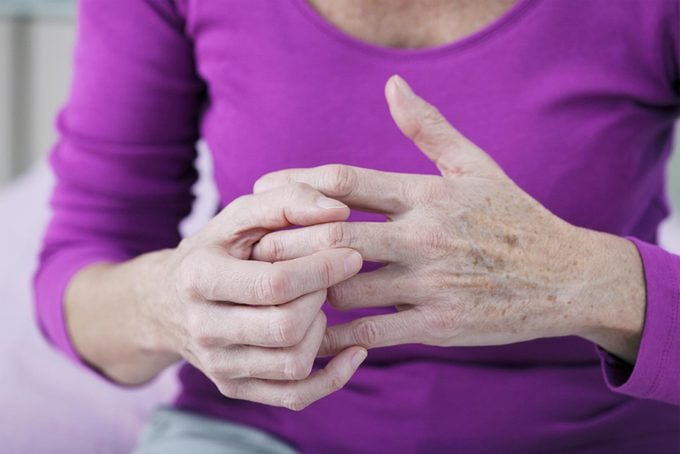If You Have This Type of Job, Your Risk for Arthritis Doubles
Updated: Oct. 23, 2020
Scientist have discovered that one kind of occupation carries a triples your risk of developing rheumatoid arthritis.
 The disease affects over a million Americans, according to the CDC. Sufferers spend up to $20,000 for treatment each year—yet their joints still swell and stiffen. Rheumatoid arthritis (RA) causes untold pain and difficulty, and can also attack the heart and lungs. If you do suffer from RA, avoiding some foods and upping your intake of others may help. And don’t forget home remedies can often ease the symptoms. However, the potential causes remain murky, though a new study suggests some manufacturing jobs may put people at increased risk.
The disease affects over a million Americans, according to the CDC. Sufferers spend up to $20,000 for treatment each year—yet their joints still swell and stiffen. Rheumatoid arthritis (RA) causes untold pain and difficulty, and can also attack the heart and lungs. If you do suffer from RA, avoiding some foods and upping your intake of others may help. And don’t forget home remedies can often ease the symptoms. However, the potential causes remain murky, though a new study suggests some manufacturing jobs may put people at increased risk.
Researchers have known for a while that factors such as heredity and smoking can increase your chances of developing the disease. Now, in a study published in Arthritis Care & Research, grad student Anna Ilar worked with colleagues at the Karolinska Institute in Sweden to investigate whether RA was more common in some occupations than others. “We know from previous research that smoking is a major risk factor for RA, ” she explained. “But it’s also believed that also other airborne exposures may increase the risk of the disease. So that is why we wanted to investigate if there was an increased risk of RA amongst certain occupations.”
Using data from the Epidemiological Investigation Into Rheumatoid Arthritis (the world’s largest study on RA), Anna’s team worked with 3,500 patients with the disease and compared them with 5,500 healthy adults. “We collected information not only through blood samples but also questionnaires, from 1996 until 2014,” she said. The detailed questionnaires allowed the researchers to focus on people’s jobs as the defining factor.
They discovered that men in occupations where they assembled electronics had double the risk of RA. Men who poured concrete or worked as bricklayers had triple the risk, says Ilar.
Women had different workplace risks, she says: “Among women, the only occupational group associated with a slight increased risk was nursing assistants. We could not detect any increased risk among women working within the manufacturing sector and we did not detect an increased risk among registered nurses,” adds Ilar.
This could be because fewer women worked in such jobs, and very few men were nursing assistants; however, further research is needed to take a closer look, Ilar says. The team did conclude that noxious airborne hazards, such as brick or concrete dust, were important factors in increasing the risk of developing RA.
What can you do to protect yourself if you work in a higher-risk occupation? Ilar offered reassurance for anyone who is concerned. “First of all, it’s important to point out that you will not necessarily develop RA just because you had a certain occupation,” she emphasized. But she does advise taking responsibility for your own safety.
“You need to make sure that you have the right protective equipment to keep yourself and others around you safe. Know your rights, and be prepared to speak up or seek help from your manager, or colleagues, or safety delegate if you suspect that the exposure levels from different harmful dusts or chemicals are too high.”
